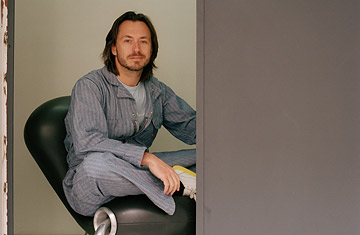
Marc Newson.
Your Lockheed Lounge recently sold at Christie's for $1.5 Million. Do today's auction prices surprise you?
Well, I'm not surprised at the prices per se. I'm surprised at how they've kept increasing. I've been looking at these things for the past 20 years. So it's not a recent phenomenon, as far as I'm concerned. I made the first Lockheed Lounge in 1986 in my garage in Australia.
What do you view as the seminal moments in your career?
There weren't any really major events where my career took off, apart from, say, leaving Australia and moving to Japan. When I left, I never thought for a minute that I wasn't going to go back. For me, it's been a very consistent path. It's not like being an actor, where you get one big film, and it's like poof, there you go, off into stardom.
What attracts you to the biomorphic forms that are a consistent element of your work?
It has to do with the way an object speaks to you on an emotional level. I would hope that if you sat down and looked at a whole variety of my work, you'd be able to link them all together. But it's actually difficult for me to see what that link is. I'm so immersed in what I do, I don't have a moment to step back and look at it—nor would I necessarily want to.
You devote a lot of your time to aviation. Why are you drawn to that industry?
What interests me is not flying so much as being involved in cutting-edge technology. As a designer, my overriding preoccupation is to break new ground. I want to be able to work with new technologies, new processes and new materials. Exposure to the aviation and aerospace industries is really the best way of doing that, because that's where all that stuff starts out and trickles down.
What was your vision for the interiors of the new Airbus A380 superjumbo jet for Qantas?
I don't know many people who like flying these days. But there was a time when everyone dreamed of it. I can still remember the first flight that I ever took. It was from Sydney to Brisbane, in Australia. I was about 10. So I always think about what it would be like to reawaken some of these emotions in travelers. The best way to do that is with a new aircraft type. You can't really do it by retrofitting an old 747.
Does that sense of wonder come into play in your design of spaceship interiors for European company Astrium?
For me, going into space, albeit for a few minutes, would be akin to getting on a plane for the first time. I'd be a bit nervous, but there's no way that a journey like that would be anything but exciting.
What else are you working on now?
I'm redesigning some of Swarovski's optical products—binoculars, telescopes. I'm designing a whole range of kitchen equipment—ovens and fridges and hot plates—for [the Italian company] Smeg. And I've got a watch company called Ikepod. That's an unusual situation because I'm part owner of the company, so it gives me a unique insight into running a business.
What are your ideal conditions for working creatively?
On my own, in absolute silence, in a relaxed environment. It happens on airplanes, at home. It never happens in my office. Philippe Starck once said that he does all of his creative stuff when he's on holiday for three months a year, and the rest of the year, he executes it all in his office.
What place do you find most inspiring?
Japan is probably the one place in the world that I find inspiring and conducive to being creative. It vibrates at a sympathetic frequency for me.
You recently became a father. Is there a line of baby products in your future?
People often say it's only a matter of time before you start designing children's furniture. But my overwhelming reaction has been not to do any of that stuff. I find that the plethora of things on the market tends to repulse me more than attract me.